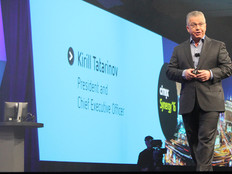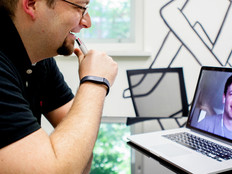Citrix Synergy 2016: Virtualized Skype Helps Businesses Become More Agile
Citrix executives and those of its partners and customers highlighted the ways in which Citrix’s technology is enabling innovation at businesses and helping them modernize their IT.
During the keynote presentation of the second day of the Citrix Synergy conference in Las Vegas, Citrix and Microsoft executives talked up their expanded partnership, particularly the introduction of a virtualized version of Skype for Business. Citrix officials also highlighted the firm’s focus on bimodal IT to help organizations span the distance between traditional IT and a more agile approach.
Citrix Puts the Focus on Skype for Business
Bill Burley, Citrix’s corporate vice president and general manager of workspace services, said that Citrix’s new partnership with Microsoft is “way more comprehensive” than anything the two companies have done before. It involves allowing Windows 10 to run on Citrix’s XenDesktop virtual desktop infrastructure platform, and tighter Citrix integration with Microsoft’s Office 365.
However, the two firms spoke at length about Citrix’s virtualization of Skype for Business. Brad Anderson, Microsoft’s corporate vice president of enterprise client and mobility, said that customers had been clamoring for such a solution, and now through the partnership the app can run partly in a customer’s data center and also in a Citrix Cloud environment.
Burley noted that last year, Paul McEwen, CIO and group head of infrastructure services at financial services firm UBS, had reached out to Citrix to set up meetings to address concerns his company had. UBS was not pleased with the performance of the virtualized high-definition desktop user experience (HDX) Citrix was delivering, McEwen said. It then became part of the early push to use a virtualized Skype for Business platform.
“The customer experience wasn’t there on the HDX link,” McEwen said “We had to improve the experience on voice, on video.”
By implementing a virtualized version of Skype for Business, McEwen said that UBS has helped untether its employees from their desks, and that 80 percent of the workers at its London headquarters are now “agile” users.
“People can move around wherever they want” to conduct business, he said, which delivered major cost savings. He added that the increased mobility meant that UBS didn’t have to expand its footprint in the building and deploy the IT and other infrastructure needed for employees on a whole new floor.
Security is also a key component of the Skype for Business deployment, McEwen said, because the data from the application never leaves UBS data centers and isn’t on loose notebooks that employees may take around the world. “If the data needs to be in Zurich, it never leaves Zurich,” he said. “If it needs to be in North America, it never leaves North America.”
Modernizing IT for a New Era
Klaus Ostermann, senior vice president and general manager of delivery networks at Citrix, discussed the concept of bimodal IT, which splits a company’s technology into two modes: one that is considered traditional IT and another that focuses on new apps. Traditional IT places a heavy emphasis on infrastructure and multitenancy requirements and is considered more monolithic. The new apps paradigm has a greater focus on applications: ease of getting started and containerization, taking a more departmental approach.
Ostermann said Citrix has been working with its partners on how to help customers bridge the gap between the two modes. One of the key elements for doing so, he said, is Citrix’s NetScaler CPX, a more lightweight version of the company’s NetScaler cloud gateway platform designed for small-scale cloud applications and container-style deployments.
Amin Kassem, enterprise vice president at health insurance company Humana, a longtime Citrix customer, noted that the firm manages 14.5 million policies. The company’s goal is to improve the health and well-being of its members by 20 percent by 2020. The secret to doing so, he said, is to engage with members on a daily basis wherever they are.
Kassem said Citrix has helped it bridge the gap between the two IT modes in a variety of ways. One was by using the NetScaler application programming interface to build a suite of apps that allowed Humana to gain visibility into its infrastructure and understand how its web apps “are being used by our members at any time, in real time.”
Over the past two years Humana has enhanced how it approaches IT and has embraced agile development methodologies and DevOps, which is a way of thinking that encourages software developers to work with IT operations staff on testing and quality assurance to develop software more quickly and automate infrastructure changes. DevOps is a collaborative mentality designed to produce software faster and more efficiently.
“All of these things are changing what we have known in traditional IT,” Kassem said. “So we have to start re-evaluating how we design our applications and how we deploy these applications.”
“How do you do that when you are starting to use software-defined networks, public and private clouds and containers?” Kassem asked. He said that Humana is using automation and orchestration techniques in its data centers to help it bridge the two modes of IT.








